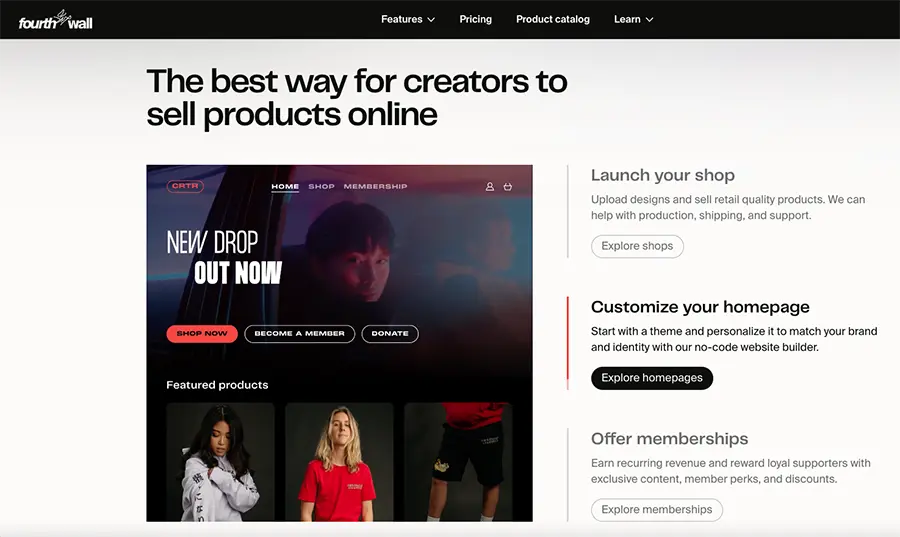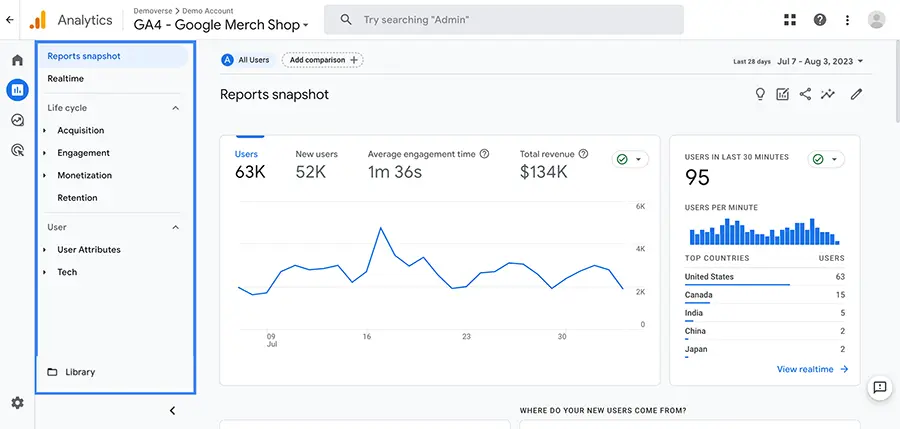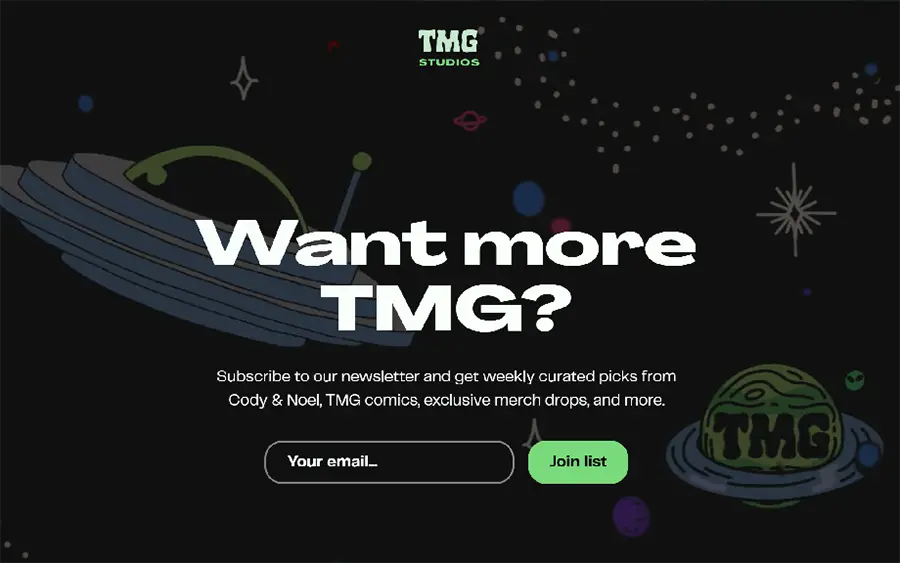How To Grow Your Online Business: 7 Strategies for Creators

So you're considering starting an online business but don't know where to begin?
Many creators today are turning to e-commerce platforms to capitalize on their brand and generate revenue through their loyal fanbase.
Whether it's setting up an online shop to sell custom apparel and goods or creating exclusive content for paid supporters on your website, starting your own business may seem like an easy cash cow, but it comes with its own set of challenges and hurdles to overcome.
From fierce competition and evolving consumer preferences to technical complexities and marketing intricacies, the journey of entrepreneurship demands resilience, adaptability, and unwavering dedication.
In this article, we'll unveil cost-effective strategies meticulously crafted to empower entrepreneurs, startups, and local businesses in their quest for online growth. Whether you're venturing into the digital realm for the first time or seeking to revitalize your online presence, our toolkit equips you with the essential tools and tactics needed to flourish in the fiercely competitive online landscape.
7 Winning Tactics To Help Grow Your Online Business
Building your online business is no easy feat. Stimulating financial growth requires a lot of planning, dedication, and commitment. If you’re having trouble getting your feet off the ground, then maybe it's time to reassess your strategies, seek guidance, or pivot your approach.
Luckily for you, we have the necessary tactics to help you grow your online business in no time. Here are seven proven strategies every creator should follow when growing their business online.
1. Choose the Right Platform for Your Site
Selecting the appropriate hosting platform is vital for creators aiming to establish a strong online presence. If you’re on a budget, finding an e-commerce platform that offers cost-effective solutions without compromising essential features like product listings, inventory management, and payment processing functionalities is crucial.
Additionally, customization options play a significant role in maintaining brand consistency and creating a unique online shopping experience for your customers. Look for platforms that provide customizable templates, themes, and design elements, allowing you to tailor your website to reflect your brand identity and stand out in the competitive online marketplace.
Platforms like Fourthwall provide comprehensive e-commerce solutions tailored to creators looking to sell their products or services. This all-in-one platform gives creators full control of their online store and provides them with a range of marketing and promotional tools to help them reach a wider audience.
Fourthwall provides creators with a centralized platform to build, promote, and sell their products, from customizable storefronts and product listings to integrated social media sharing and email campaigns.

2. Understand Your Audience
Now, this might seem like a no-brainer, but you would be surprised at how many entrepreneurs rush into starting an online business without considering their target audience’s needs and preferences. To get a better understanding of what your audience is looking for, try employing these four strategies:
- Conduct Market Research: Utilize surveys, focus groups, and data analytics tools to gather information about your target audience's demographics, preferences, and behaviors.
- Create Buyer Personas: Develop detailed profiles of your ideal customers based on demographic data, interests, motivations, and pain points. This helps tailor marketing efforts and product offerings to specific audience segments.
- Offer Personalized Recommendations: Use data-driven algorithms to provide personalized product recommendations based on user's past purchases, browsing history, and preferences. This enhances the user experience and increases the likelihood of conversion.
- Analyze Website Analytics: Use tools like Google Analytics to track user behavior on your website, including page views, bounce rates, and conversion rates. This data provides insights into user preferences and areas for improvement.

3. Craft Compelling SEO Content
Content marketing is a powerful strategy for creators to grow their online business as it helps attract a wider audience and establishes you as an authority within your niche.
In addition, implementing search engine optimization (SEO) tactics in your content can significantly enhance your site’s conversions by improving its visibility on search engine results pages like Google. Here are some content marketing ideas that can help drive traffic to your online store:
- Blog Posts: Creating high-quality blog posts that address topics relevant to your audience can drive organic traffic to your website. For instance, if your online store sells clothes and apparel, you could write articles on the latest fashion trends, styling tips, or wardrobe-essentials.
Optimize your blog post titles, headings, meta descriptions, and content with targeted keywords related to your niche. By conducting keyword research and strategically incorporating relevant keywords into your blog posts, you can improve your chances of ranking higher in search engine results pages (SERPs).
- Newsletters: Send out weekly newsletters that inform your customers on upcoming events, exclusive offers, or industry insights. Include calls-to-action (CTAs) with links back to your website for readers to explore further content or browse through your product listings.
Newsletters are also a great way to collect feedback from your customers. Incorporating interactive content into your newsletters, such as surveys, quizzes, or polls, can help you gain valuable insights into your customers' preferences, needs, and pain points, which can improve future product development and marketing strategies.

- Video Tutorials or Guides: Producing video tutorials or guides related to your products not only showcases your expertise but helps cement your brand as reliable and trustworthy. For example, if you're a fitness coach, you could create workout videos demonstrating different exercises or nutrition guides for achieving specific fitness goals.
Sharing these videos on platforms like YouTube or TikTok can attract viewers interested in your content and direct them to your website for more resources or services. Conduct research to identify popular search queries within your niche and incorporate these keywords naturally into your video titles, descriptions, and tags.
- Podcasts: Hosting a podcast where you discuss topics relevant to your business can help drive traffic to your website. For instance, if you're a marketing coach, you could host a podcast series where you interview successful entrepreneurs or provide actionable advice on business growth strategies.
At the end of each episode, encourage your listeners to check out your site so they can learn more about the topics you discuss or inform them of new products and services featured on your online shop.
4. Leverage Social Media
Let’s be honest: Most businesses today need a social media presence to stay relevant. Platforms like Pinterest, Facebook, Instagram, and TikTok offer unparalleled opportunities for creators to market and sell their products while connecting with their customers on a more personal level.
To make sure you’re leveraging your social media channels to tailor your business’s needs effectively, follow these key strategies:
- Engagement and Interaction: Actively engage with your audience by responding to comments, messages, and mentions on social media. Foster conversations, answer questions and express appreciation for your followers' support. This interaction helps build rapport and loyalty among your audience.
- Integrate Shoppable Features: In the last couple of years, many social media platforms have included shoppable features that allow creators to integrate their products or online store into their content.
Platforms like TikTok Shop enable brands and sellers to showcase and sell products directly on TikTok through a suite of in-app shopping touchpoints, while Instagram Shopping incorporates product tags that let you highlight items from your catalog directly in your Reels, Stories, and Feed.
In addition, YouTube allows eligible creators to connect their store to their channel, allowing them to tag products in their videos and live streams and automatically direct users to the products page.
With Fourthwall, creators can easily integrate their online shop into any of these platforms, creating a pleasant shopping experience that makes purchasing products simpler for their supporters.
- Influencer Collaborations: Collaborate with influencers or other creators in your niche to reach a broader audience. Creating shareable sponsored content, joint giveaways, or co-created projects can expose your brand to new followers and potential customers.
- User-Generated Content (UGC): Encourage your audience to create and share content related to your brand or products. Share user-generated content on your social media profiles to showcase customer testimonials, reviews, and experiences. UGC not only builds community but also serves as authentic social proof for your brand.
- Hashtag Campaigns: Create branded hashtags and encourage your followers to use them when sharing content related to your brand or campaigns. This increases brand visibility, fosters community engagement, and makes it easier to track user-generated content associated with your brand.
- Paid Advertising: Utilize social media advertising platforms, such as Facebook Ads, Instagram Ads, Twitter Ads, and LinkedIn Ads, to target specific demographics, interests, or behaviors relevant to your target audience. Paid advertising can help increase brand awareness, drive website traffic, and generate leads or sales.
5. Mobile Optimization
Optimizing websites for mobile accessibility is non-negotiable in today’s digital landscape. With mobile devices accounting for a significant portion of internet traffic, tailoring your website for mobile ensures a user-friendly experience for users who are constantly glued to their phones and tablets. Below are some steps to consider when optimizing your website for mobile accessibility:
- Mobile-Friendly Website Design: Ensure that your website is optimized for mobile devices with responsive design elements. This includes easy navigation, fast loading times, and content that displays correctly across various screen sizes. A mobile-friendly website enhances user experience and encourages visitors to explore your content and make purchases.
- Mobile-Optimized Content: Create content that is specifically tailored for mobile consumption. This could include short-form videos, vertical images, or concise written content that is easy to read on smaller screens. Consider platforms like Instagram, TikTok, or Snapchat, which are popular among mobile users, and adapt your content strategy accordingly to reach a wider audience.
- Mobile Payment Options: Offer mobile-friendly payment options to streamline the checkout process for customers using smartphones or tablets. Integrating mobile payment methods like Apple Pay, Google Pay, or mobile wallets can reduce friction during the purchasing journey and increase conversion rates on mobile devices.
- Mobile Apps: Consider developing a mobile app for your online business to provide a more immersive and convenient shopping experience for mobile users. Mobile apps can offer personalized recommendations, push notifications, and exclusive deals, fostering customer loyalty and driving repeat purchases.
With Fourthwall Mobile Apps, you can give your supporters instant access to your members’ area and the rest of your site straight from their phones. Mobile Apps also allow push notifications for new content and comment replies to help increase engagement in your shop.
6. Run Contest and Giveaways
Everyone loves free stuff—that’s just a common fact. By offering free products or exclusive prizes through contests and giveaways, you not only create goodwill among your audience but also incentivize them to engage with your content, share your brand with others, and ultimately become loyal customers.
Here are some fun contest ideas and giveaways you can incorporate through your site or social media channels:
- Photo or Video Contest: Encourage followers to share photos or videos featuring your products in creative ways. Offer a prize for the best submission, and showcase entries on your social media channels to generate excitement and encourage participation.
- Caption Contest: Share a photo or image and ask followers to submit their best captions. Choose the most creative or funny caption as the winner and reward them with a prize, such as a discount on their next purchase or a free product.
- Referral Giveaway: Reward existing customers or followers for referring friends or family to your online business. Offer incentives such as discounts, freebies, or exclusive access to new products for each successful referral.
- Holiday-themed Giveaway: Host a giveaway to celebrate holidays or special occasions, such as Valentine's Day, Halloween, or your business anniversary. Offer themed prizes or discounted bundles to spread holiday cheer and attract attention to your brand.
- Flash Sale or Limited-time Offer: Create a sense of urgency by hosting a flash sale or limited-time offer exclusively for contest participants or followers. Offer exclusive discounts or bundles to incentivize immediate action and drive sales.
7. Start an Affiliate Partner Program
If your online shop is starting to gain some traction and you want to start pushing your products even further, consider launching an affiliate program to expand your brand’s visibility.
In order to kickstart an affiliate program effectively, you must lay out a clear plan and define what your program’s goals are. Whether you aim to boost sales, enhance brand awareness, or drive website traffic, having well-defined objectives will guide your program's structure and execution.
Once you've outlined your goals, craft an enticing commission structure with competitive commission rates and incentives that will attract potential affiliates to join your program. Consider factors like average order value, profit margins, and industry standards when determining your rates. The more compelling your incentives are, the more motivated your affiliates will be to promote your products.
Next, scout and recruit the right affiliates for your program. To reach potential affiliates, utilize various channels such as social media, affiliate networks, and industry forums. Highlight the benefits of joining your program, including earning potential, support resources, and promotional opportunities.
By effectively communicating the advantages of becoming an affiliate for your business, you can attract high-quality partners who will contribute to the success of your program and help drive growth for your online business.
FAQs
How Can I Measure the Success of My Online Business Growth Efforts?
Utilize analytics tools to track website traffic, conversion rates, and customer engagement metrics. Set clear goals and regularly assess your progress.
Which Type of Business Grows the Fastest?
Businesses that adapt quickly to market trends, provide innovative solutions and effectively utilize online channels for marketing and sales often experience rapid growth.
What Are the Biggest Challenges to Online Business Growth?
Common challenges include fierce competition, changes in consumer behavior, and staying updated with evolving digital marketing trends. Overcoming these hurdles requires adaptability and strategic planning.
What Are Some Essential Tools and Resources for Online Business Growth?
Key tools include SEO software, content management systems (CMS), email marketing platforms, analytics tools, and e-commerce platforms. Stay informed about industry trends through reputable sources and communities.
Your business can thrive in the dynamic digital landscape by implementing these strategies and leveraging platforms like Fourthwall. Stay adaptable, focus on customer satisfaction, and watch your online presence grow.
Take Your Business to New Heights with Fourthwall
As you embark on your journey to grow your online business, consider the advantages Fourthwall offers.
This innovative platform empowers creators to personalize their online store effortlessly. With easily customizable designs, layouts, and features, Fourthwall enables you to craft a distinctive brand that reflects your individuality.
Sign up with Fourthwall today and unleash your creativity in building an online business that captures viewer's attention and leaves a lasting impression.
















